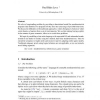Free Online Productivity Tools
i2Speak
i2Symbol
i2OCR
iTex2Img
iWeb2Print
iWeb2Shot
i2Type
iPdf2Split
iPdf2Merge
i2Bopomofo
i2Arabic
i2Style
i2Image
i2PDF
iLatex2Rtf
Sci2ools
APAL
2008
2008
Infinite trace equivalence
We solve a longstanding problem by providing a denotational model for nondeterministic programs that identifies two programs iff they have the same range of possible behaviours. We discuss the difficulties with traditional approaches, where divergence is bottom or where a term denotes a function from a set of environments. We see that making forcing explicit, in the manner of game semantics, allows us to avoid these problems. We begin by modelling a first-order language with sequential I/O and unbounded nondeterminism (no harder to model, using this method, than finite nondeterminism). Then we extend the semantics to higher-order and recursive types by adapting earlier game models. Traditional adequacy proofs using logical relations are not applicable, so we use instead a novel hiding argument. Key words: nondeterminism, infinite traces, game semantics
| Added | 08 Dec 2010 |
| Updated | 08 Dec 2010 |
| Type | Journal |
| Year | 2008 |
| Where | APAL |
| Authors | Paul Blain Levy |
Comments (0)

